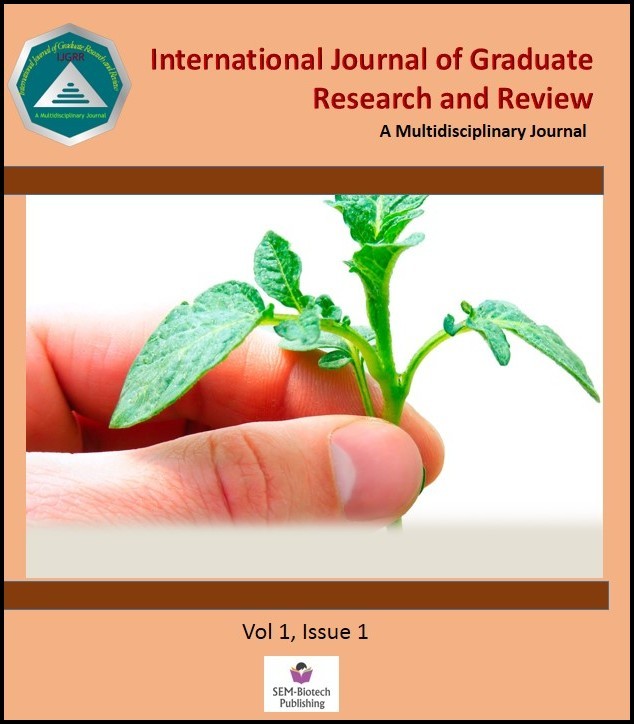





Evaluation of Repellent Plant Materials for Management of the Maize Weevil (Sitophilus zeamais) in Storage Condition
Sundar Tiwari*
Department of Entomology, Agriculture and Forestry University of Nepal, Chitwan, Nepal
Sundar Tiwari*
Department of Entomology, Agriculture and Forestry University of Nepal, Chitwan, Nepal
Abstract
Maize weevil, Sitophilus zeamais Mots. (Coleoptera: Curculionidae) is an important storage pest of maize and other cereal crops such as wheat, rice and barley in humid tropical regions. The infestation of pest has been recorded up to 80 % in worse conditions. However, damages on maize in storehouse can be influenced by moisture and storage conditions. Regarding its management, farmers of south Asian regions have been used a chemical pesticide called Celphos (Aluminum phosphide), a toxic poison releasing chemical. This chemical is extremely poisonous to human health and the environment. Hence, an alternative benign approach of pest management has been realized for the sustainable control of this pest. A laboratory study was conducted by using various potential repelling plant materials in Chitwan Nepal from March to November 2017. These treatments materials were: Acoros calamus L. rhizome dust (Sweet flag), Azadirachta indica A. Juss. seed powder (Neem), Artemisia vulgaris L. leaf dust (Common mugwort), Zanthoxylum armatum DC fruit powder (Prickly ash), Melia azedarach L. seed powder (Chinaberry tree), Justicia adhatoda L. leaf dust (Malabar nut). All of these materials were compared with the susceptible control (no-treatments). Experiment design was a complete randomized block design with three replication for each replicate. The average temperature and humidity of the storehouse were 27.5oc and 75% RH respectively. At the end of the data observation, less than one percent grain damage was recorded in A. calamus treated maize grains followed by J. adhatoda, and maximum damage was recorded in control maize. The number of holes per 100g was lowest in A. calamus treated maize and more numbers of holes were recorded in control. Acorus calamus and A. indica treated maize have lowest weevil population but control maize had highest weevil population. The highest weight loss was recorded in control and the lowest weight loss was in A. calamus treated maize grains. This informationís suggested that A. calamus is the most potential plant material to repel the maize weevil from the storehouse
Keywords: Sitophilus zeamais; Acorus calamus; maize weevil; storage; weight loss; grain loss
Maize weevil, Sitophilus zeamais Mots. (Coleoptera: Curculionidae) is an important storage pest of maize and other cereal crops such as wheat, rice and barley in humid tropical regions. The infestation of pest has been recorded up to 80 % in worse conditions. However, damages on maize in storehouse can be influenced by moisture and storage conditions. Regarding its management, farmers of south Asian regions have been used a chemical pesticide called Celphos (Aluminum phosphide), a toxic poison releasing chemical. This chemical is extremely poisonous to human health and the environment. Hence, an alternative benign approach of pest management has been realized for the sustainable control of this pest. A laboratory study was conducted by using various potential repelling plant materials in Chitwan Nepal from March to November 2017. These treatments materials were: Acoros calamus L. rhizome dust (Sweet flag), Azadirachta indica A. Juss. seed powder (Neem), Artemisia vulgaris L. leaf dust (Common mugwort), Zanthoxylum armatum DC fruit powder (Prickly ash), Melia azedarach L. seed powder (Chinaberry tree), Justicia adhatoda L. leaf dust (Malabar nut). All of these materials were compared with the susceptible control (no-treatments). Experiment design was a complete randomized block design with three replication for each replicate. The average temperature and humidity of the storehouse were 27.5oc and 75% RH respectively. At the end of the data observation, less than one percent grain damage was recorded in A. calamus treated maize grains followed by J. adhatoda, and maximum damage was recorded in control maize. The number of holes per 100g was lowest in A. calamus treated maize and more numbers of holes were recorded in control. Acorus calamus and A. indica treated maize have lowest weevil population but control maize had highest weevil population. The highest weight loss was recorded in control and the lowest weight loss was in A. calamus treated maize grains. This informationís suggested that A. calamus is the most potential plant material to repel the maize weevil from the storehouse
Keywords: Sitophilus zeamais; Acorus calamus; maize weevil; storage; weight loss; grain loss
Full text: PDF
Int. J. Grad. Res. Rev.Vol-5, Issue-1: 12-16



